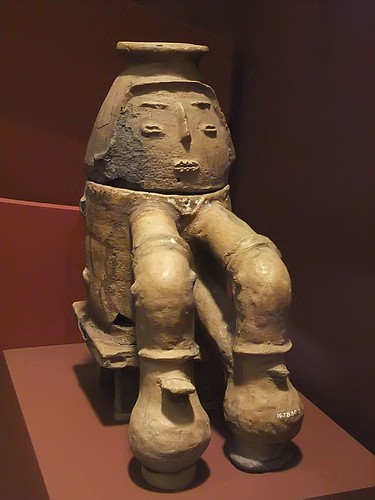 |
| Amazonian Ceramic Figure from the state of Amapa in Brazil 1200-1600CE. Photographed at the Field Museum in Chicago by Mary Harrsch. |
Along the Xingu, an Amazon tributary in Brazil, Michael Heckenberger of the University of Florida has found moats, causeways, canals, the networks of a stratified civilization that, he says, existed as early as A.D. 800. In Bolivia, American, German and Finnish archaeologists have been studying how pre-Columbian Indians moved tons of soil and diverted rivers, major projects of a society that existed long before the birth of Christ.
Many of these ongoing excavations follow the work of Anna C. Roosevelt. In the 1980s on Marajo Island, at the mouth of the Amazon, she turned up house foundations, elaborate pottery and evidence of an agriculture so advanced she believes the society there possibly had well over 100,000 inhabitants.
In some ways, the theory that the Amazon may have been a wellspring of civilization should come as no surprise in the 21st century. In a long perilous journey along Ecuador's Napo River in 1541, Spanish friar Gaspar de Carvajal, a chronicler of the European conquest, wrote of "cities that gleamed white," canoes that carried dozens of Indian warriors, "fine highways" and "very fruitful land."
Bits of colorful ceramics - matching that found elsewhere in the Amazon - seem to show that those who lived here were the Omaguas, the same people Gaspar de Carvajal encountered nearly 500 years before. - Scientists find evidence discrediting theory Amazon was virtually unlivable by Juan Forero for the Washington Post
Most of our documentation about the Omaguas was compiled by 17th century missionary Samuel Fritz. By his time, the average Omagua settlement had been reduced to, on average, 28 plank houses with palm-thatched roofs where about 330 individuals, most members of an extended family, lived.
Men and women wore cloth garments. The men wore long sleeveless shirts that reached down to their knees. Women wore short wraparound skirts. The men usually left their shirts off because they got in the way. The clothes were usually painted with multicolor designs. Due to the Omaguas flattened foreheads they are easily distinguished from other Amazonian tribes. Fritz observed that shaping was done in infancy by “ applying to the [babies’] forehead a small board or wattle of reeds tied with a little cotton so as not to hurt them, and fastening them by the shoulders to a little canoe, which serves them for a cradle” (Meggers 125).
The spearthrower was the principle weapon for hunting, fishing, and gathering. It took the form of a flat board about 40 inches long and three fingers wide with a bone hook at the upper end to secure the projectile. The spear or arrow was about six feet long and had a point of bone or very hard wood which was sometimes detachable, permitting it to remain in the victim. To shoot the arrow is taken in the right hand, with which the spearthrower is held by its lower end, and placing the arrow against the hook, they launch it with such force and accuracy that they do not miss at fifty paces” ( Meggers 127). The shields used in warfare were the height of a man and made of basketry covered with cayman, manatee, or tapir hide. If there was no stone, turtle shells were used for axes and adzes.
Each village had a chief and all the villages in a province were united under one high chief who was described as “ a very great over lord.” - Nick Willaert, Minnesota State University at Mankato




No comments:
Post a Comment